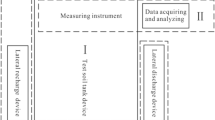Abstract
The mathematical models laid down in the new blocks of the INSOLAR.GSHP.12 software system simulating unsteady operating conditions of ground-source heat-pump (GSHP) heat supply systems are presented. The new model blocks take into account the effect the freezing of porous moisture in soil has on the GSHP system performance efficiency. Illustration is given to the need of taking into account the porous moisture freezing/thawing processes in soil, and the results from investigations devoted to the opening possibilities of constructing adaptive GSHP systems with controlled intensity of heat transfer in the soil-thermal well system are presented. The development of software simulating the porous moisture phase state variation processes in soil was preceded by development of mathematical equations representing the thermal conditions of soil body involving porous moisture freezing/thawing processes. A description of these equations is also given in the article. In constructing the mathematical model, the notion “effective thermal conductivity” of soil was introduced for taking into account the latent heat of phase transition that releases during the freezing of moisture. The above-mentioned effective thermal conductivity of soil involves two components: the soil thermal conductivity coefficient itself and an additional term modifying the thermal conductivity value for taking into account the influence of phase transition. For quantitatively evaluating the soil effective thermal conductivity component that takes into account the influence of phase transition, the soil freezing zone radius around the thermal well was determined. The obtained analytic solutions have been implemented in the form of computer program blocks, after which a “numerical experiment” was carried out for estimating the effect the porous moisture freezing/thawing processes have on the soil thermal conditions. It was demonstrated during that experiment that the soil thermal conductivities determined without taking the porous moisture freezing/thawing phase transitions can differ from those determined with taking these transitions into account by a factor of 2 or more. A conclusion has been drawn from these findings about the importance of taking the phase transition phenomena into account in modeling the parameters of thermal wells and of the GSHP system as a whole.
Similar content being viewed by others
References
J. W. Lund, D. H. Freeston, and T. L. Boyd, “Direct utilization of geothermal energy 2010 worldwide review,” Geothermics, No. 40, 159–180 (2011).
G. P. Vasil’ev, “Operating experience with geothermal heat-pump heat-supplying systems and the technical aspects of integrating them rationally in the energy balance of Russia,” Therm. Eng. 51(6), 459 (2004).
G. P. Vasil’ev, “Results from full-scale investigations of the thermal operating conditions of an experimental energy-efficient house,” Stroit. Mat., Oborud., Tekhnol. XXI Veka, No. 6, 3–5 (2002).
S. C. Gupta, The Classical Stefan Problem: Basic Concepts, Modeling and Analysis (Elsevier, 2003).
H. Yang, P. Cui, and Z. Fang, “Vertical-borehole ground-coupled heat pumps: A review of models and systems,” Appl. Energy, No. 87, 16–27 (2010).
L. Lamarche, S. Kajl, and B. Beauchamp, “A review of methods to evaluate borehole thermal resistances in geothermal heat-pump systems,” Geothermics, No. 39, 187–200 (2010).
H. S. Carslaw and J. C. Jaeger, Conduction of Heat in Solids (Claremore Press, Oxford, 1946).
L. R. Ingersoll, O. J. Zobel, and A. C. Ingersoll, Heat Conduction with Engineering, Geological, and Other Applications (McGraw-Hill, New York, 1954).
Author information
Authors and Affiliations
Corresponding author
Additional information
Original Russian Text © G.P. Vasilyev, N.V. Peskov, V.A. Lichman, V.F. Gornov, M.V. Kolesova, 2015, published in Teploenergetika.
Rights and permissions
About this article
Cite this article
Vasilyev, G.P., Peskov, N.V., Lichman, V.A. et al. Simulating the thermal operating conditions in the thermal wells of ground-source heat-pump heat supply systems. Part I: Porous moisture freezing processes in soil. Therm. Eng. 62, 547–552 (2015). https://doi.org/10.1134/S004060151508008X
Published:
Issue Date:
DOI: https://doi.org/10.1134/S004060151508008X



